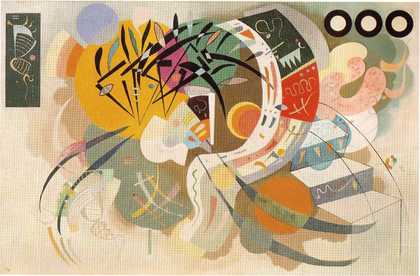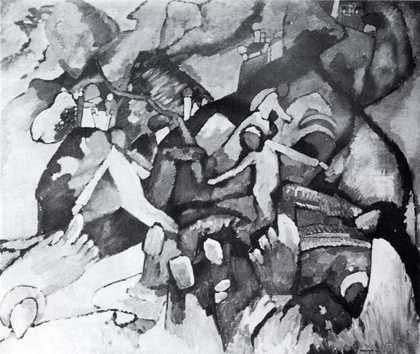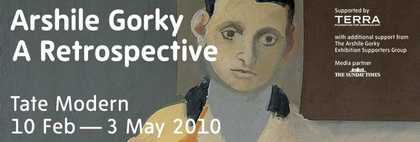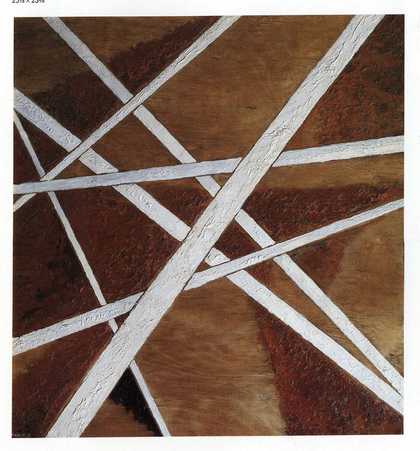My subject is not contemporary artists who may claim to be ‘influenced’ by the early Kandinsky in some way. There are always some of those, and the best of luck to them. I am more interested in what a truly contemporary awareness can make of the early Kandinsky in the light of Tate Modern’s recent exhibition. Kandinsky really did believe, in common with others of his generation, that painting could embody the deepest meanings of his time – that ‘colours in a certain order’ could penetrate the depths of consciousness, deliver perceptual sensations that went right to the heart of cognition and awareness. In this sense he was a modern painter – one who believed that meaning could be embedded in a medium. A century later, we are more likely to see painting reach for quotation, irony or detachment – to wear the consciousness of the ‘end of painting’ directly on its sleeve. The question is therefore whether contemporary painting has abandoned the mission of modernity or whether modernity in Kandinsky’s sense can still be claimed to be the language we speak. On the one hand, most artists today will tell you that modernist depth is no longer achievable – that the medium of painting cannot bear the weight of deep consciousness or revelatory sensation (and that in any case utopias are not to be trusted). On the other hand, Kandinsky’s painting is sensuously rich. We need to ask questions about the workings and also about the relevance of its pleasures now.
I want to suggest that the abstractness or objectlessness that is claimed for the early Kandinsky is no longer usefully thought of as a matter of ‘veiling’ images from Biblical scenes or the lives of the Saints – and that the terminology of ‘inner sounds’ and ‘the epoch of the Great Spiritual’ is pretty much exhausted today. I believe that, right from the start, abstractness was never intended to mean the end of pictorial culture as such; rather that what counted as ‘the pictorial’ and the culture of the pictorial was being put under pressure to change very fast and in some unpredictable ways. We may look at a painting of Kandinsky’s pre-Moscow period (before the late part of 1914) and notice that, even though lacking in middle-sized objects bathed in rational light and exhibiting their familiar colour, several other marks of the traditional scheme of painting remain: the sense of a near-ground at the lower edge whose entities are somehow closer to the eye; a turbulent middle distance in which ‘something happens’; and a sense of a rear-ground near the picture’s upper edge in which the tops of buildings or skies or at any rate ‘higher events’ occur (fig.1). Almost all Kandinsky’s paintings before 1921 contain something like this spatial scheme – even if the ‘events’ as I have called them seem to belong, not to the rational spatial continuum of ordinary reality (middle-sized things having a relation to human scale) but to sub-aqueous or cosmic reality (the very small or the very large) where different laws of physics and optics apply. To say that different laws of nature apply is to say that light, colour and movement happen differently in the zones of the minute and the massive respectively. We can see today that these shifts into the aqueous or the cosmic are among the earliest of Kandinsky’s major pictorial inventions – even if he refers to them infrequently in his writings of the time. And these scale-effects (as I want to call them) would become important in the light of the path that painting was soon to follow.
I am giving an account of the viewer’s experience of Kandinsky’s painterly effects as an experience of events, that is, of unfolding time. Bruno Haas in his essay for the catalogue of the Kandinsky exhibition makes an ambitious attempt to locate the temporality of Kandinsky’s pre-Bauhaus paintings when he proposes that they are composed out of chromatic chords, ‘black-blue-white’, ‘brown-blue-green’ and so on as the case may be, with ‘echoes’ or ‘sequences’ filling out or demonstrating the sense in which Kandinsky was thinking about music as the essential analogy for colour and form. The musical analogy was in one sense ideal in that it could function on two sensory levels simultaneously: both as sensuously parallel to colour (at the limit, synaesthetically) but also as a linguistic system that enabled the translation of the visual into words. Yet music provides an imprecise way of translating visual data into the verbal if we think of other features of the painting. For whatever advantage is gained by speaking of chords, harmonies, tonalities and so forth – the price paid is a sudden loss of contact with the phenomena of shape, linearity and more broadly form, the visual elements most fundamental to visual art and also central to the culture of European painting as it was soon to unfold. Secondly, we need to distinguish at least two senses of time in the swirling, eventful paintings of Kandinsky’s early art. There is the assumed speed, slowness, inevitability, unpredictability and so forth of the pictorial events themselves. Just how fast or suddenly or imperceptibly slowly is that patch of green encroaching upon that vermilion shape that surrounds it? At what pace and at what scale do these lines shoot at or predate upon or engulf some others? Exactly what form of reading does the painting want? Like all paintings it wants to be looked upon and valued in some terms. But Kandinsky’s early abstract paintings seem to want to be seen as pictorial dramas into which the viewer can enter in a way that is immediate, sudden and somehow new.
We can understand this better if we think about the other kind of time, namely the time of viewing itself; and here I think Haas it exactly right when he observes that what he calls ‘the sudden flash of temporality’ in the picture ‘has little to do with the rather banal notion that the various parts of the picture are successively grasped by the spectator’. On the contrary, he says, time in the picture ‘is emphatically experienced suddenly, in the here and now’.1 We seem to have passed imperceptibly from an account of Kandinsky’s early painting as modern in the sense of gegenstandlos or abstract to a deeper and more contestable account of it as modernist in the sense of Michael Fried when he famously wrote, about certain paintings and sculptures of the 1960s, that their quality as shape was to be grasped instantaneously, however prolonged or considered the literal time of viewing might be. ‘Presentness [as he put it in his final famous sentence] is grace’.2 To talk about pictorial ‘drama’ in the early Kandinsky then is not to talk about music and not to talk about theatre; rather a kind of visual arena in which things ‘occur’ but not in sequential (linear) time. We might say that although the structure may be one of chords, they are chords having neither sonority, nor key, nor real duration.
This slightly paradoxical mode of being for the picture is confirmed by Kandinsky himself in his ‘Reminiscences/Three Pictures’ essay, written in the middle of 1913, sometime between Composition VI and Composition VII, and then re-written in Moscow in 1918 under the auspices of IZO, Lunacharsky’s Commissariat of Enlightenment. He is describing his journey by train and boat through the province of Vologda and his arrival in villages ‘where suddenly the entire population was clad in gray from head to toe, with yellowish-green faces and hair, or suddenly displayed variegated costumes that ran about like brightly coloured, living pictures on two legs’. In the two-storied wooden houses or izba, he tells us, ‘I experienced something I have never encountered again since. They taught me to move within the picture, to live in the picture’. ‘I stood rooted to the spot before this unexpected scene . Folk pictures (lubki) on the walls; a symbolic representation of a hero, a battle, a painted folk song. The “red” corner thickly, completely covered with painted and printed pictures of the saints, burning in front of it the red flame of a small pendant lamp, glowing and blowing like a knowing, discreetly murmuring, modest, and triumphant star, existing in and for itself’. That seems to me both a challenging and adequate description of modernist pictorial experience as it would more widely soon become. As Kandinsky says, ‘I felt surrounded on all sides by painting [not the painting, please note, but painting], into which I had thus penetrated’. The sensation of ‘moving within the picture, living within the picture’, from this point onwards becomes the effect that he tries to achieve: as he puts it, ‘letting the viewer “stroll” within the picture, forcing him to become absorbed in the picture, forgetful of himself’.3
Here then is one form of pictorial autonomy, and one that matches remarkably well the experience of the modernist viewer, both early and late. The trouble has always been that Kandinsky’s own prose (of which there is much too much) is misleading and even at times childish. He is talking about the upper left-hand corner of the Guggenheim Museum’s Picture with a White Edge of 1913: ‘Right in the corner are white zig-zag forms, expressing a feeling I am unable to convey in words. It awakens the feeling, perhaps, of an obstacle, which is, however, ultimately unable to deter the progress of the troika [the three horses heads that are visible from behind]’. Or on the second of the painting’s two centres, to the right: ‘Broad, curving brushstrokes. This second center has, both towards the outside and on the inside, incandescent (almost white) zig-zag forms, which bestow upon the rather melancholy character of this curved shape the overtones of an energetic “inner boiling”; which is extinguished . by the dull-blue tones, which only occasionally attain a more strident pitch and which, taken together, enclose the upper part of the picture with a more or less egg-shaped background’.4 Or this description of Composition VI, also of 1913, a painting notionally founded upon an image of the deluge: ‘If the left-hand scale goes down too far, then you have to put a heavier weight on the right – and the left will come up of its own accord. The exhausting search for the right scale, for the exact missing weight, the way in which the left scale trembles at the merest touch on the right, the tiniest alterations of drawing and colour in such a place that the whole picture is made to vibrate – this permanently living, immeasurably sensitive quality of a successful picture – this is the third, beautiful and tormenting moment in painting’ – a passage that I suggest evokes much too nearly the picturesque in art, with its loose and somehow untimely adherence to pictorial ‘balance’ and ‘resolution’. But Kandinsky then describes the third of three ‘centers’ in the picture in a way that says something relevant about the surface of modernist art. ‘Here the pink and the white seethe in such a way that they seem to lie neither upon the surface of the canvas nor upon any ideal surface. Rather, they appear as if hovering in the air, as if surrounded by steam’. In an amusing aside he compares this apparent absence of surface, this uncertainty as to distance, to the Russian steam baths. ‘A man standing in the steam is neither close to nor far away; he is just somewhere. This feeling of “somewhere” about the principal center determines the inner sound of the whole picture’. 5 It is a rare moment in Kandinsky’s prose when he figures a purely pictorial theory within a flow of otherwise uncontrolled subjectivism, anthropomorphism, reading-in – an almost fanatical obsession with features relating to compositional balance and control. It is exactly the problem we face in connecting Kandinsky’s concerns to our own. What he tells us about the autonomy of the pictorial drama and the absorption into it of the modernist viewer is constantly burdened by references to the vegetable, biological and musical worlds, seemingly mixed up together as if in a kind of unverifiable fantasy.
That sense of verbal and imaginative overkill in Kandinsky’s early writings is the main reason, surely, why his version of pictorial autonomy soon clashed with a very different one. The difficulties he suffered in revolutionary Russia may be summarised very quickly. For most of 1917, the whole of 1918 and the first part of 1919, he paints almost nothing. Invited to join the Narkompros Fine Art section, he works in organisation and administration. As a founder member of MZhK, the Museum of Painterly Culture, he works alongside Rodchenko and others to set up a network of provincial museums and furnish them with works of art, including several of his own. He resumes painting, and in 1920 is instrumental in founding the Institute of Artistic Culture or InKhuK, whose inaugural program he presents early in June 1920 to a mixed and partly hostile audience – for our purposes, the part that mattered. He was already under scrutiny by Nikolai Punin, a close ally of Tatlin: ‘Down with Kandinsky! Down!’ Punin had already written. ‘Everything in his art is accidental and individualistic’.6 Kandinsky’s efforts to divine the general laws of colour and form in his pedagogic programmes are denounced increasingly as pseudo-scientific, pseudo-psychological. ‘The InKhuK has totally “Kandinskified” ’, wrote Stepanova despairingly in her diary for 25 November 1920. ‘Everything is being transformed into an elusive emotion, into a spiritual necessity, that is quite impossible to characterise or express . in words. We, formalists and materialists, have decided to launch a schism’.7 That schism, involving first Rodchenko, Popova and Vavara Bubnova but soon joined by others, was the Working Group of Objective Analysis, who within a year had re-christened themselves Constructivists, with open warfare now joined between several new concepts of ‘construction’ and Kandinsky’s own allegiance to ‘composition’. The task of the Constructivists was ‘the theoretical analysis of the basic elements of a work of art’ and not ‘the psychology of creation or the psychology of aesthetic perception’ – ‘the analysis of elements and the laws of their organisation in works of art’. The prizing away and dismantling of the subjective laws of composition – the replacement of ‘plastic necessity’ by ‘mechanical necessity’ – urged especially forcibly by Rodchenko in the early months of 1921 – forced a fundamental realignment of ideas in the Russian avant-garde that effectively sundered modernism as a whole.
Slogans such as ‘no superfluous elements’, ‘the move into three dimensions’, ‘economy’ and so on demoralised Kandinsky and caused him to leave the country in quick order. He was probably right to do so. ‘At present in Moscow . the “how” [of painting] has become singularly out of fashion’, he is reported as saying in the same year. ‘Instead of creating paintings, works, one makes experiments. One practices experimental art in laboratories . this is the view of a few young painters who push the materialistic viewpoint to absurdity’.8 He complains about the paperwork, about shortages, about isolation. Though he showed a total of fifty-four works including Composition VII (1913) and In Grey (1919) at the 19th State Exhibition in Moscow in October 1920, it was to be his last substantial exhibition there until 1989.9
Kandinsky’s verdict on the Constructivists was as stark as theirs was upon him. ‘In truth, these artists are mechanics [he says] . yet they produced machines deprived of movement, engines that do not move, planes that do not fly’. He adds: ‘This is why most “Constructivists” have very quickly stopped painting’.10 The Formalists who supported them were likewise too technical and too lacking in ‘inner necessity’. As for the idea of what a ‘modern’ artist was or should be in the 1920s, the field was becoming more and more a conflicted one. To some, a ‘modernist’ in the 1920s and 1930s was simply someone concerned with keeping ‘up to date’ – with fashion, architecture, and style. But in specialist discussion of the fine arts it was much more; and after Kandinsky moved to Paris in 1933 he had to be content with watching at a distance the development of painting in places where his own work was frequently though selectively shown.
We shall look here at New York, where the terminology of painting and the other fine arts was undergoing inevitable and significant change. A modernist there would soon be an artist who understood something about autonomy and self-criticism – not as personal values but as artistic ones, even though they may at some level amount to the same thing; and who increasingly needed to grapple with problems of America’s provincialism, and hence with its disconnectedness from European art. Let us explain it this way. The question that the Russian Formalists had asked about literature in the 1910s and 1920s, namely, ‘What is the literariness of literature?’, had had an unanswered counterpart in painting: ‘What is the paintingness (zhivopisnost) of painting?’ The great technical theorists of the Opoyaz school, Jakobson and Eichenbaum and others, would now see their questions become strangely Kantian and teleological, at least in the eyes of the ‘new’ Formalism that took root in the United States. For what the Americans took from Kandinsky when they saw his work displayed there during the Second World War was not the quasi-Biblical or synaesthetic analogies that he tried to pursue, rather an underlying conception of painting as dramatic, absorbing, other-worldly – as a display of pictorial pyrotechnics in its own right and answerable to its own kind of sense. Significantly it was not paintingness but painterliness that now became the attractive quality in Kandinsky’s pre-Bauhaus work.

Arshile Gorky
Waterfall (1943)
Tate
The story according to the formalist critic Clement Greenberg is roughly as follows. Ambitious abstract painting in 1930s America was still – even up to the early 1940s – fixated on synthetic Cubism, that is, on ‘trued and faired, silhouetted and flattened forms’. Writing in ‘After Abstract Expressionism’ in 1962, in the full wisdom of hindsight, Greenberg claimed, ‘The sense of how confining serious abstract art had become under the canons of closed Cubism betrayed itself in the feeling that Stuart Davis had to be overcome rather than emulated’.11 A loosening-up was somehow in the air, combined with an intuition that American painting needed linking somehow with the main streams of European art. In Greenberg’s account, the Americans who became ‘abstract expressionists’ did this by taking their lead, as he puts it, from ‘German, Russian and Jewish expressionism’ (Kandinsky had claims to be all three) filtered though School of Paris style. ‘Of the utmost importance [to those who were to come after Picasso]’, said Greenberg, ‘was the accessibility of a large number of early Kandinskys in what is now the Solomon Guggenheim Museum. All in all, this marked the first time that a generation of American artists could start out fully abreast – and perhaps even a little bit ahead – of their contemporaries elsewhere’ – the latter from ‘American-Type Painting’ of 1955.12 Evidently, it was Kandinsky’s two shows at Nierendorf’s in New York in 1941 and 1945 that prompted Greenberg to admire his ‘earlier liquescent style’ and to bemoan the geometrical decorations of his Bauhaus days (he called them ‘plastically irrelevant’). Thus: ‘the Slavic peasant colours are rich and strong when brushed with the vigour and freedom of his earlier manner, but they become superficial when fixed with draughtsman’s precision in dry, spic-and-span diagrams resembling nothing so much as astronomical charts and patterns for dirndl dresses’.13 First of all Gorky became more painterly, thanks in part to the early Kandinskys that he knew and looked at closely (fig.2). Then Clifford Still, who showed how contours could be made less jumpy by narrowing the value-contrasts between the two shapes either side, as Kandinsky is described as having done. Then Pollock, whose Peggy Guggenheim show in 1943 showed a new painterliness at least partly inspired by his time as a custodian at the Museum of Non-Objective Painting (later the Solomon Guggenheim Museum) in the same year (fig.3). But, above all, Hans Hofmann, who had been in Paris between 1907 and 1914 and had opened a painting school in Munich in 1915, and in whose studio some early Kandinsky paintings had been stored (including some Improvisations).14 ‘Perhaps the most difficult artist alive’, is how Greenberg described Hofmann in 1959, ‘difficult to grasp and appreciate’. Converging with, rather than dependant upon the early Kandinsky, Hofmann had learnt something from ‘Kandinsky’s swirl’ but ultimately achieved something broader because it ‘ran through the whole of Matisse and the whole of Cubism’.15 And it was thanks for Hofmann’s ‘open, pulsating textures’ that abstract expressionism finally transcended the closed surfaces of Cubist collage. More generally, abstract expressionism ‘meant painterliness: loose, rapid handling, or the look of it; masses that blotted and fused instead of shapes that stayed distinct; large and conspicuous rhythms . in short, a constellation of qualities like those defined by Wöllflin when he extracted his notion of the malerische from Baroque art’.16
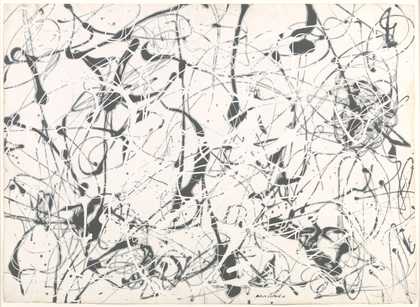
Jackson Pollock
Number 23 (1948)
Tate
I have dwelt upon Greenberg’s methods here not to defend them – and especially not Wöllflin’s idea of a cyclical alternation between painterly and non-painterly style – rather to emphasise that for a short interval between roughly 1940 and 1950 painterliness became a major value in New York painting – where it stood for experiment, looseness, largeness, the freedom to dispense altogether with the brush: a manner associated with individualism as well as the idea of the ‘advanced’ in American art. It seems to me that today’s painting does not speak the same language – barely recognises it – except as a remote historical reference, capable of being emulated, of course, but more likely to constitute a reference to a respected but essentially forgotten past. What, after all, is painterliness now? The claim made by (and on behalf of) Albert Oehlen’s paintings recently at the Whitechapel Art Gallery was for not for balance or pictorial control, but on the contrary for ‘bad’ painting in the form of heterogeneity, mess, ugliness: qualities that point towards the desperation that people may feel in the face of the terror and backwardness of the times. This brings me directly to a final speculation about the reach of Kandinsky’s early abstraction – one that touches upon that difficult and slightly cloying phrase of his, the crisis of ‘the spiritual in art’. In 1906, from Kandinsky’s base in Southern Germany, the catastrophe was perceived to be that of nineteenth-century materialism and its consequences, especially greed, shallowness and an unhealthy orientation to objects. The crisis of ‘the spiritual’ today can only mean the politically-sanctioned clash of religious fundamentalisms (the Muslim and the Christian right) and a pervasive anxiety about endings, instability, the collapse of entire value-systems and the onset of religious war. For the early twentieth century and the early twenty-first alike, the question is in one sense the same: what can painting do in the face of such a disintegrating world? But the dominant contemporary answer – the most compelling and the most frequently heard in the culture of today’s painting – is surely nothing.
The best that can be done is to indicate how the idea of pictorial complexity as such – Kandinsky’s best intuition both early and late – can in isolated cases furnish suggestive cognitive models for the newer forms of data-organisation that are coming to articulate and perhaps dominate thought and vision alike. Now, a new computer language has emerged, one of networks, systems and data-flow, of non-hierarchical patterning and of the spatial and logical relations within them; patterns which provide ways of imaging the forms taken by guerrilla terrorism, asymmetrical warfare, intelligence and (of course) its corruptibility, legality, and control. From the rhizome to the wave and back again, some contemporary painting has tried to attune itself to these new conception of relatedness and scale – what I elsewhere recently characterised as the ‘fundamentally biological character of everything’.17 Painters like Julie Mehretu or Matthew Ritchie have attempted to visualise these patterns and to evoke the kinds of complexity that the pictorial can still (just) command. But at this distance their debt to the early Kandinsky seems to me to be very small.

